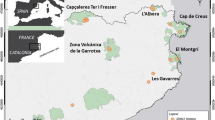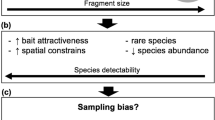Abstract
Assessing species richness of small mammal communities is an important research objective for many live-trapping studies designed to assess or monitor biological diversity. We tested the effectiveness and efficiency of various trap densities for determining estimates and counts of small mammal species richness. Trapping was conducted in grassland habitats in northeastern Kansas during spring and fall of 2002 and 2003. Estimates and counts of species richness were higher at increased trap densities. This effect appeared to be primarily due to the higher number of individuals sampled at higher trap densities. At least 3 nights duration was needed to produce a stable estimate of species richness for the range of trap densities tested (9–144 trap stations/ha). Higher trap densities generally reached stable richness estimates in fewer nights than low density trapping arrangements. Given that counts and estimates of species richness were influenced by trap density and sampling duration, it is critical that these parameters are selected to most effectively meet research objectives.
Similar content being viewed by others
References
Althoff D. P., Gipson P. S., Pontius J. S. and Woodford P. B. 2006. Plant community and bare ground trends on Fort Riley, Kansas: implications for monitoring a highly disturbed landscape. Transactions of the Kansas Academy of Science 109: 101–119.
Anderson C. S. and Meikle D. B. 2006. Annual changes in structural complexity of understory vegetation and relative abundance ofPeromyscus leucopus in fragmented habitats. Acta Theriologica 51: 43–51.
Andrianjakarivelo V., Razafimahatratra E., Razafindrakoto Y. and Goodman S. M. 2005. The terrestrial small mammals of the Parc National de Masoala, northeastern Madagascar. Acta Theriologica 50: 537–549.
Baumgardt J. A. 2005. The effects of trapping methods on estimation of population parameters for small mammals. MSc thesis, Kansas State University, Kansas: 1–80.
Bowman J., Corkum C. V. and Forbes G. J. 2001. Spatial scales of trapping in small mammal research. The Canadian Field-Naturalist 115: 472–475.
Brewer A. and Williamson M. 1994. A new relationship for rarefaction. Biodiversity and Conservation 3: 373–379.
Caro T. M. 2001. Species richness and abundance of small mammals inside and outside an African national park. Biological Conservation 98: 251–257.
Chao A. 1987. Estimating the population size for capture-recapture data with unequal catchability. Biometrics 43: 783–791.
Clark B. K., Kaufman D. W., Kaufman G. A., Finck E. J. and Hand S. S. 1988. Long-distance movements byReithrodontomys megalotis in tallgrass prairie. American Midland Naturalist 120: 276–281.
Collins S. L. and Glenn S. M. 1991. Importance of spatial and temporal dynamics in species regional abundance and distribution. Ecology 72: 654–664.
Colwell R. K. 2000. Estimates: Statistical Estimation of Species Richness and Shared Species from Samples (Software and User’s Guide), Version 7. http://viceroy. eeb.uconn.edu/estimates.
Colwell R. K. and Coddington J. A. 1994. Estimating terrestrial biodiversity through extrapolation. Philosophical Transactions of the Royal Society of London: Biological Sciences 345: 101–118.
Conard J. M. 2003. Responses of small mammals and their predators to military disturbance in tallgrass prairie. MSc thesis, Kansas State University, Kansas: 1–91.
Engqvist L. 2005. The mistreatment of covariate interactions terms in linear model analyses of behavioural and evolutionary ecology studies. Animal Behaviour 70: 967–971.
Fryxell J. M., Falls J. B., Falls E. A. and Brooks R. J. 1998. Long-term dynamics of small-mammal populations in Ontario. Ecology 79: 213–225.
Gannon W. L. and Sikes R. S. 2007. Guidelines of the American Society of Mammalogists for the use of wild mammals in research. Journal of Mammalogy 88: 809–823.
Gotelli N. J. and Colwell R. K. 2001. Quantifying biodiversity: procedures and pitfalls in the measurement and comparison of species richness. Ecology Letters 4: 379–391.
Gotelli N. J. and Entsminger G. L. 2007. EcoSim: Null models software for ecology, Version 7. Acquired Intelligence Inc. & Kesey-Bear, Jericho, VT. http://garyentsminger.com/ecosim.htm.
Granjon L., Houssin C., Lecompte E., Angaya M., Cesar J., Cornette R., Dobigny G., and Denys C. 2004. Community ecology of terrestrial small mammals of Zakouma National Park, Chad. Acta Theriologica 49: 215–234.
Horton D. R. and Redak R. A. 1993. Further comments on analysis of covariance in insect dietary studies. Entomologia Experimentalis et Applicata 69: 263–275.
Huitema B. E. 1980. The analysis of covariance and alternatives. Wiley, New York: 1–445.
Kaufman G. A. and Kaufman D. W. 2006. Terrestrial mammals of the Smoky Hills Army National Guard Training Facility, Saline County, Kansas. Transactions of the Kansas Academy of Science 109: 120–124.
Lambert T. D., Malcom J. R. and Zimmerman B. L. 2005. Variation in small mammal species richness by trap height and trap type in southeastern Amazonia. Journal of Mammalogy 86: 982–990.
MacKenzie D. I., Nichols J. D., Hines J. E., Knutson M. G., Franklin A. B. 2003. Estimating site occupancy, colonization, and local extinction when a species is detected imperfectly. Ecology 84: 2200–2207.
MacKenzie D. I., Nichols J. D., Lachman G. B., Droege S., Royle J. A. and Langtimm C. A. 2002. Estimating site occupancy rates when detection probabilities are less than one. Ecology 83: 2248–2255.
MacKenzie D. I., Nichols J. D., Royle J. A., Pollock K. H., Hines J. E. and Bailey L. L. 2006. Occupancy estimation and modeling: inferring patterns and dynamics of species occurrence. Academic Press, California: 1–344.
Magurran A. E. 1988. Ecological diversity and its measurement. Princeton University Press, New Jersey: 1–192.
McNab B. K. 1963. Bioenergetics and the determination of home range size. The American Naturalist 97: 133–140.
Milliken G. A. and Johnson D. E. (eds) 2002. Analysis of messy data v(3): analysis of covarianc. Chapman Hall/CRC, Florida: 1–605.
Myers N., Mittermeier R. A., Mittermeier C. G., Fonseca G. A. B. and Kent J. 2000. Biodiversity hotspots for conservation priorities. Nature 403: 853–858.
Otis D. L., Burnham K. P. and White G. C. White and Anderson D. R. 1978. Statistical inference from capture data on closed animal populations. Wildlife Monographs 62: 1–135.
Ott R. L. and Longnecker M. (eds) 2001. An introduction to statistical methods and data analysis. 5th ed. Duxbury Press, California: 1–1184.
Peterson A. T. and Slade N. A. 1998. Extrapolating inventory results into biodiversity estimates and the importance of stopping rules. Diversity and Distributions 4: 95–105.
Pitts R. M., Levalley M. G. and Klinger S. 1987. Mammals of Fort Riley, Kansas. Transactions of the Kansas Academy of Science 90: 75–80.
Pollock K. H., Nichols J., Brownie C. and Hines J. 1990. Statistical inference from capture-recapture experiments. Wildlife Monographs 107: 1–97.
Quinn G. P. and Keough M. J. 2002. Experimental design and analysis for biologists. Cambridge University Press, Cambridge: 1–537.
Robinson G. R., Holt R. D., Gaines M. S., Hamburg S. P., Johnson M. L., Fitch H. S. and Mattinko E. A. 1992. Diverse and contrasting effects of habitat fragmentation. Science 257: 524–526.
SAS V9. 2002. SAS for Windows, version 9.0. SAS Institute Inc., Cary, NC.
Sauer J. R. and Williams B. K. 1989. Generalized procedures for testing hypotheses about survival or recovery rates. The Journal of Wildlife Management 53: 137–142.
Schlesser M., Boulenge E. L. and Schtickzelle N. 2002. Can demographic parameters be estimated from capture-recapture data on small grids? A test with forest rodents. Acta Theriologica 47: 323–332.
Shanker K. 2000. Small mammal trapping in tropical montane forests of the Upper Nilgris, southern India: an evaluation of capture-recapture models in estimating abundance. Journal of Biosciences 25: 99–111.
Skalski J. R. and Robson D. S. 1992. Techniques for wildlife investigations: design and analysis of capture data. Academic Press, California: 1–237.
Slade N. A., Eifler M. A., Gruenhagen N. M. and Davelos A. L. 1993. Differential effectiveness of standard and long Sherman livetraps in capturing small mammals. Journal of Mammalogy 74: 162–167.
Stanley W. T. and Hutterer R. 2007. Differences in abundance and species richness between shrews and rodents along an elevational gradient in the Udzungwa Mountains, Tanzania. Acta Theriologica 52: 261–275.
Steele B. B., Bayn Jr R. L. and Grant C. V. 1984. Environmental monitoring using populations of birds and small mammals: analyses of sampling effort. Biological Conservation 30: 157–172.
Swihart R. K. and Slade N. A. 1990. Long-term dynamics of an early successional small mammal community. American Midland Naturalist 123: 372–382.
Torre I., Arrizabalaga A. and Flaquer C. 2004. Three methods for assessing richness and composition of small mammal communities. Journal of Mammalogy 85: 524–530.
Weihong J. I., Veitch C. R. and Craig J. L. 1999. An evaluation of the efficiency of rodent trapping methods: the effect of trap arrangement, cover types, and bait. New Zealand Journal of Ecology 23: 45–51.
Wiens J. A. 1989. Spatial scaling in ecology. Functional Ecology 3: 385–397.
Williams S. E., Marsh S. and Winter J. 2002. Spatial scale, species diversity, and habitat structure: small mammals in Australian tropical rain forest. Ecology 83: 1317–1329.
Wilson D. E., Cole F. R., Nichols J. D., Rudran R. and Foster M. S. 1996. Measuring and monitoring biological diversity. Standard methods for mammals. Smithsonian Insitution Press, Washington D.C.: 1–409.
Woodman N., Timm R. M., Slade N. A. and Doonan T. J. 1996. A comparison of traps and baits for censusing small mammals in neotropical lowlands. Journal of Mammalogy 77: 274–281.
Yoccoz N. G., Nichols J. D. and Boulinier T. 2001. Monitoring of biological diversity in space and time. Trends in Ecology and Evolution 16: 446–453.
Author information
Authors and Affiliations
Corresponding author
Additional information
Associate editor was Magdalena Niedziałkowska.
Rights and permissions
About this article
Cite this article
Conard, J.M., Baumgardt, J.A., Gipson, P.S. et al. The influence of trap density and sampling duration on the detection of small mammal species richness. Acta Theriol 53, 143–156 (2008). https://doi.org/10.1007/BF03194247
Revised:
Accepted:
Issue Date:
DOI: https://doi.org/10.1007/BF03194247




